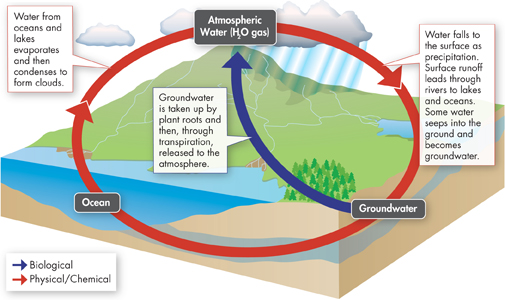The Water Cycle
 How does water cycle through the biosphere?
How does water cycle through the biosphere?
Every time you see rain or snow, or watch a river flow, you are witnessing part of the water cycle.  Water continuously moves between the oceans, the atmosphere, and land—sometimes outside living organisms and sometimes inside them. As Figure 3–15 shows, water molecules typically enter the atmosphere as water vapor, a gas, when they evaporate from the ocean or other bodies of water. Water can also enter the atmosphere by evaporating from the leaves of plants in the process of transpiration (tran spuh RAY shun).
Water continuously moves between the oceans, the atmosphere, and land—sometimes outside living organisms and sometimes inside them. As Figure 3–15 shows, water molecules typically enter the atmosphere as water vapor, a gas, when they evaporate from the ocean or other bodies of water. Water can also enter the atmosphere by evaporating from the leaves of plants in the process of transpiration (tran spuh RAY shun).
Water vapor may be transported by winds over great distances. If the air carrying it cools, water vapor condenses into tiny droplets that form clouds. When the droplets become large enough, they fall to Earth's surface as precipitation in the form of rain, snow, sleet, or hail. On land, some precipitation flows along the surface in what scientists call runoff, until it enters a river or stream that carries it to an ocean or lake. Precipitation can also be absorbed into the soil and is then called groundwater. Groundwater can enter plants through their roots, or flow into rivers, streams, lakes, or oceans. Some groundwater penetrates deeply enough into the ground to become part of underground reservoirs. Water that re-enters the atmosphere through transpiration or evaporation begins the cycle anew.
 In Your Notebook Define each of the following terms and describe how they relate to the water cycle: evaporation, transpiration, precipitation, and runoff.
In Your Notebook Define each of the following terms and describe how they relate to the water cycle: evaporation, transpiration, precipitation, and runoff.

Figure 3–15 The Water Cycle This diagram shows the main processes involved in the water cycle. Scientists estimate that it can take a single water molecule as long as 4000 years to complete one cycle. Interpret Visuals What are the two primary ways in which water that falls to Earth as precipitation passes through the water cycle?
d
Table of Contents
- Formulas and Equations
- Applying Formulas and Equations
- Mean, Median, and Mode
- Estimation
- Using Measurements in Calculations
- Effects of Measurement Errors
- Accuracy
- Precision
- Comparing Accuracy and Precision
- Significant Figures
- Calculating With Significant Figures
- Scientific Notation
- Calculating With Scientific Notation
- Dimensional Analysis
- Applying Dimensional Analysis




